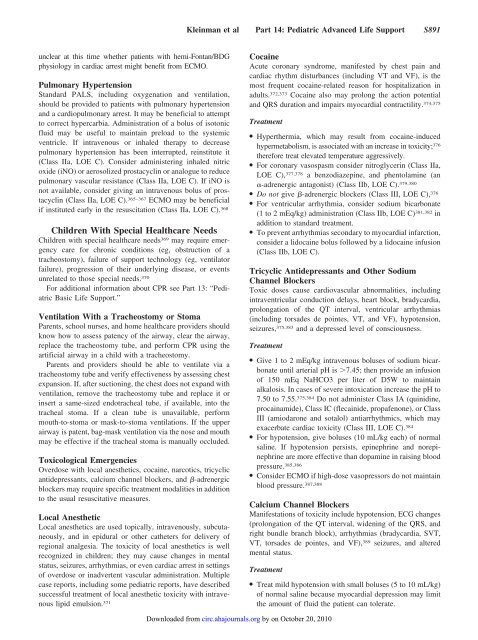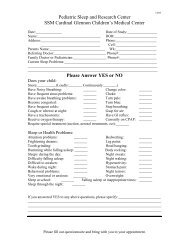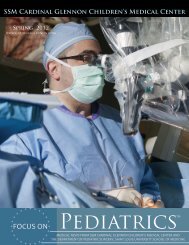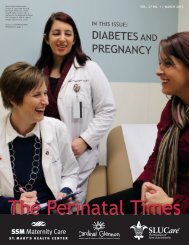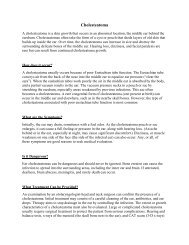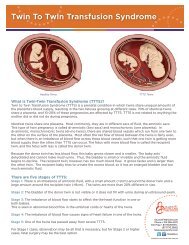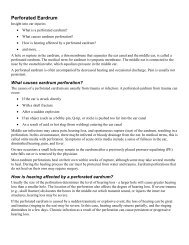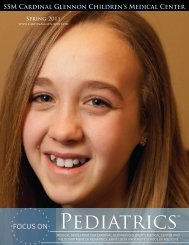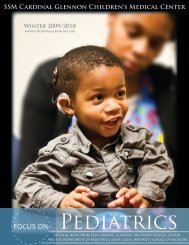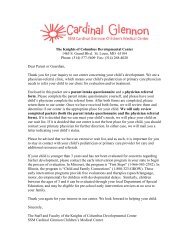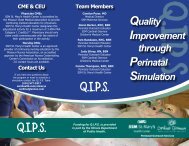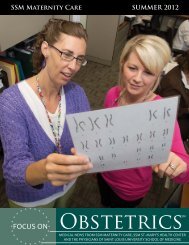S890 Circulation November 2, <strong>2010</strong>suppression is seen after administration of etomidate inchildren 323 and adults. 324 In children and adults with septicshock, etomidate administration is associated with a highermortality rate. 323,325Hypovolemic Shock● Use an isotonic crystalloid solution (eg, lactated Ringer’ssolution or normal saline) 326,327 as the initial fluid for thetreatment of shock (Class I, LOE A). There is no addedbenefit in using colloid (eg, albumin) during the earlyphase of resuscitation. 328,329● Treat signs of shock with a bolus of 20 mL/kg of isotoniccrystalloid even if blood pressure is normal (Class IIb, LOE C).Crystalloids may have an associated survival benefit overcolloid for children with shock secondary to general trauma,traumatic brain injury, and burns. 329–332 There is no evidenceto support the use of a specific isotonic crystalloid. Giveadditional boluses (20 mL/kg) if systemic perfusion fails toimprove. There are insufficient data to make a recommendationfor or against use of hypertonic saline for shock associatedwith head injuries or hypovolemia. 333,334● There is insufficient evidence in infants and children tomake a recommendation about the best timing or extent ofvolume resuscitation for children with hemorrhagic shockfollowing trauma.TraumaSome aspects of trauma resuscitation require emphasis becauseimproperly performed resuscitation is a major cause ofpreventable <strong>pediatric</strong> deaths. 335Common errors in <strong>pediatric</strong> trauma resuscitation includefailure to open and maintain the airway, failure to provideappropriate fluid resuscitation, and failure to recognize andtreat internal bleeding. Involve a qualified surgeon early and,if possible, transport a child with multisystem trauma to atrauma center with <strong>pediatric</strong> expertise.The following are special aspects of trauma resuscitation:● When the mechanism of injury is compatible with cervicalspinal injury, restrict motion of the cervical spine and avoidtraction or movement of the head and neck. Open andmaintain the airway with a jaw thrust, and do not tilt thehead.● If the airway cannot be opened with a jaw thrust, use a headtilt–chin lift because you must establish a patent airway.Because of the disproportionately large head of infants andyoung children, optimal positioning may require recessingthe occiput 336 or elevating the torso to avoid undesirablebackboard-induced cervical flexion. 336,337● Do not routinely hyperventilate even in case of head injury(Class III, LOE C). 338,339 Intentional brief hyperventilationmay be used as a temporizing rescue therapy if there aresigns of impending brain herniation (eg, sudden rise inmeasured intracranial pressure, dilation of one or bothpupils with decreased response to light, bradycardia, andhypertension).● Suspect thoracic injury in all thoraco-abdominal trauma,even in the absence of external injuries. Tension pneumothorax,hemothorax, or pulmonary contusion may impairoxygenation and ventilation.● If the patient has maxillofacial trauma or if you suspect abasilar skull fracture, insert an orogastric rather than anasogastric tube (Class IIa, LOE C). 340● In the very select circumstances of children with cardiacarrest from penetrating trauma with short transport times,consider performing resuscitative thoracotomy (Class IIb,LOE C). 341,342● Consider intra-abdominal hemorrhage, tension pneumothorax,pericardial tamponade, and spinal cord injury ininfants and children, and intracranial hemorrhage in infants,as causes of shock. 343,344Single VentricleStandard prearrest and arrest resuscitation procedures shouldbe followed for infants and children with single ventricleanatomy following Stage I palliation or in the infant orneonate with a univentricular heart and a shunt to augmentpulmonary blood flow. Heparin may be considered for infantswith a systemic-pulmonary artery shunt or right ventricularpulmonaryartery shunt. Following resuscitation from cardiacarrest, oxygen administration should be adjusted to balancesystemic and pulmonary blood flow, targeting an oxyhemoglobinsaturation (SpO 2 ) of approximately 80%. End-tidalCO 2 (PETCO 2 ) in the single-ventricle patient during cardiacarrest may not be a reliable indicator of CPR quality becausepulmonary blood flow changes rapidly and does not necessarilyreflect cardiac output during CPR. 345Neonates in a prearrest state due to elevated pulmonaryto-systemicflow ratio prior to Stage I repair might benefitfrom a PaCO 2 of 50 to 60 mm Hg, which can be achievedduring mechanical ventilation by reducing minute ventilation,increasing the inspired fraction of CO 2 , or administeringopioids with or without chemical paralysis (Class IIb,LOE B). 346,347 Neonates in a low cardiac output state followingstage I repair may benefit from systemic vasodilators such as-adrenergic antagonists (eg, phenoxybenzamine) to treat orameliorate increased systemic vascular resistance, improvesystemic oxygen delivery, and reduce the likelihood ofcardiac arrest (Class IIa, LOE B). 348–350 Other drugs thatreduce systemic vascular resistance (eg, milrinone or nipride)351 may also be considered for patients with excessiveQp:Qs (Class IIa, LOE B). 352 Following Stage I repair,evaluation of oxygen delivery and extraction (eg, usingcentral venous oxygen saturation [ScvO 2 ] and near-infraredspectroscopy) may help identify evolving changes in hemodynamicsthat may herald impending cardiac arrest. 353–355During cardiopulmonary arrest, it is reasonable to considerextracorporeal membrane oxygenation (ECMO) for patientswith single ventricle anatomy who have undergone Stage Iprocedure (Class IIa, LOE B). 129,132,152,356,357Hypoventilation may improve oxygen delivery in patientsin a prearrest state with Fontan or hemi-Fontan/bidirectionalGlenn (BDG) physiology (Class IIa, LOE B). 358–361 Negativepressureventilation may improve cardiac output (Class IIa,LOE C). 362,363 During cardiopulmonary arrest, it is reasonableto consider extracorporeal membrane oxygenation (ECMO) forpatients with Fontan physiology (Class IIa, LOE C). 364 It isDownloaded from circ.ahajournals.org by on October 20, <strong>2010</strong>
Kleinman et al Part 14: Pediatric Advanced Life Support S891unclear at this time whether patients with hemi-Fontan/BDGphysiology in cardiac arrest might benefit from ECMO.Pulmonary HypertensionStandard P<strong>ALS</strong>, including oxygenation and ventilation,should be provided to patients with pulmonary hypertensionand a cardiopulmonary arrest. It may be beneficial to attemptto correct hypercarbia. Administration of a bolus of isotonicfluid may be useful to maintain preload to the systemicventricle. If intravenous or inhaled therapy to decreasepulmonary hypertension has been interrupted, reinstitute it(Class IIa, LOE C). Consider administering inhaled nitricoxide (iNO) or aerosolized prostacyclin or analogue to reducepulmonary vascular resistance (Class IIa, LOE C). If iNO isnot available, consider giving an intravenous bolus of prostacyclin(Class IIa, LOE C). 365–367 ECMO may be beneficialif instituted early in the resuscitation (Class IIa, LOE C). 368Children With Special Healthcare NeedsChildren with special healthcare needs 369 may require emergencycare for chronic conditions (eg, obstruction of atracheostomy), failure of support technology (eg, ventilatorfailure), progression of their underlying disease, or eventsunrelated to those special needs. 370For additional information about CPR see Part 13: “PediatricBasic Life Support.”Ventilation With a Tracheostomy or StomaParents, school nurses, and home healthcare providers shouldknow how to assess patency of the airway, clear the airway,replace the tracheostomy tube, and perform CPR using theartificial airway in a child with a tracheostomy.Parents and providers should be able to ventilate via atracheostomy tube and verify effectiveness by assessing chestexpansion. If, after suctioning, the chest does not expand withventilation, remove the tracheostomy tube and replace it orinsert a same-sized endotracheal tube, if available, into thetracheal stoma. If a clean tube is unavailable, performmouth-to-stoma or mask-to-stoma ventilations. If the upperairway is patent, bag-mask ventilation via the nose and mouthmay be effective if the tracheal stoma is manually occluded.Toxicological EmergenciesOverdose with local anesthetics, cocaine, narcotics, tricyclicantidepressants, calcium channel blockers, and -adrenergicblockers may require specific treatment modalities in additionto the usual resuscitative measures.Local AnestheticLocal anesthetics are used topically, intravenously, subcutaneously,and in epidural or other catheters for delivery ofregional analgesia. The toxicity of local anesthetics is wellrecognized in children; they may cause changes in mentalstatus, seizures, arrhythmias, or even cardiac arrest in settingsof overdose or inadvertent vascular administration. Multiplecase reports, including some <strong>pediatric</strong> reports, have describedsuccessful treatment of local anesthetic toxicity with intravenouslipid emulsion. 371CocaineAcute coronary syndrome, manifested by chest pain andcardiac rhythm disturbances (including VT and VF), is themost frequent cocaine-related reason for hospitalization inadults. 372,373 Cocaine also may prolong the action potentialand QRS duration and impairs myocardial contractility. 374,375Treatment● Hyperthermia, which may result from cocaine-inducedhypermetabolism, is associated with an increase in toxicity; 376therefore treat elevated temperature aggressively.● For coronary vasospasm consider nitroglycerin (Class IIa,LOE C), 377,378 a benzodiazepine, and phentolamine (an-adrenergic antagonist) (Class IIb, LOE C). 379,380● Do not give -adrenergic blockers (Class III, LOE C), 376● For ventricular arrhythmia, consider sodium bicarbonate(1 to 2 mEq/kg) administration (Class IIb, LOE C) 381,382 inaddition to standard treatment.● To prevent arrhythmias secondary to myocardial infarction,consider a lidocaine bolus followed by a lidocaine infusion(Class IIb, LOE C).Tricyclic Antidepressants and Other SodiumChannel BlockersToxic doses cause cardiovascular abnormalities, includingintraventricular conduction delays, heart block, bradycardia,prolongation of the QT interval, ventricular arrhythmias(including torsades de pointes, VT, and VF), hypotension,seizures, 375,383 and a depressed level of consciousness.Treatment● Give 1 to 2 mEq/kg intravenous boluses of sodium bicarbonateuntil arterial pH is 7.45; then provide an infusionof 150 mEq NaHCO3 per liter of D5W to maintainalkalosis. In cases of severe intoxication increase the pH to7.50 to 7.55. 375,384 Do not administer Class IA (quinidine,procainamide), Class IC (flecainide, propafenone), or ClassIII (amiodarone and sotalol) antiarrhythmics, which mayexacerbate cardiac toxicity (Class III, LOE C). 384● For hypotension, give boluses (10 mL/kg each) of normalsaline. If hypotension persists, epinephrine and norepinephrineare more effective than dopamine in raising bloodpressure. 385,386● Consider ECMO if high-dose vasopressors do not maintainblood pressure. 387,388Calcium Channel BlockersManifestations of toxicity include hypotension, ECG changes(prolongation of the QT interval, widening of the QRS, andright bundle branch block), arrhythmias (bradycardia, SVT,VT, torsades de pointes, and VF), 389 seizures, and alteredmental status.Treatment● Treat mild hypotension with small boluses (5 to 10 mL/kg)of normal saline because myocardial depression may limitthe amount of fluid the patient can tolerate.Downloaded from circ.ahajournals.org by on October 20, <strong>2010</strong>


